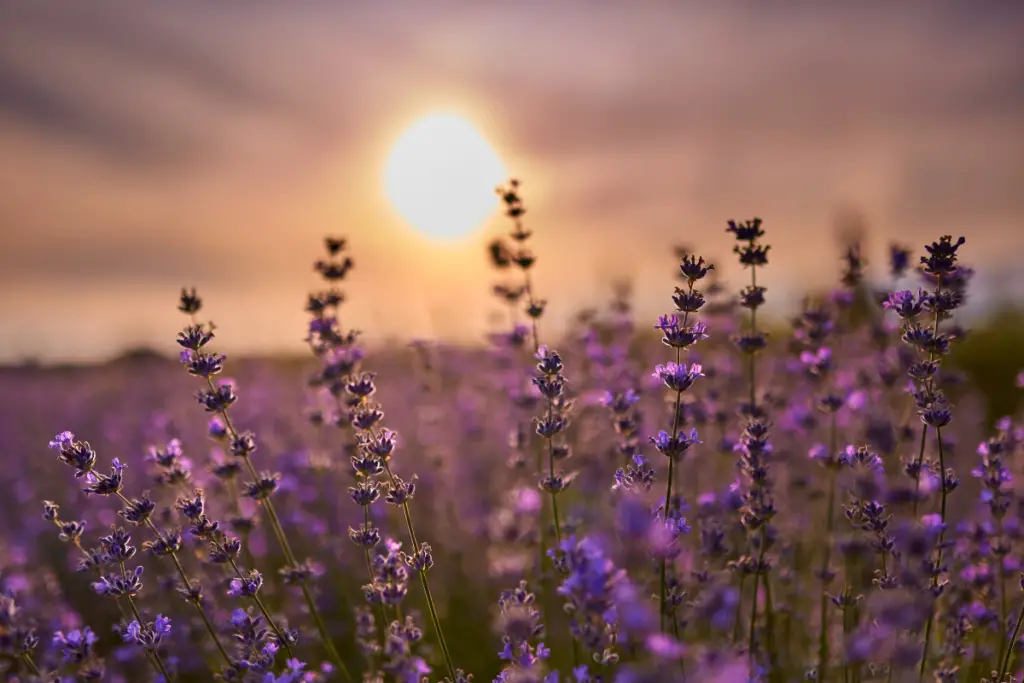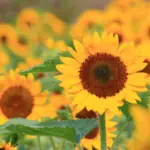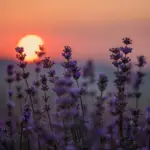When it comes to growing lavender, location is key. Lavender thrives in a warm, sunny, and dry environment with well-draining soil.
The best place to plant lavender is in a spot that receives at least six hours of direct sunlight a day.
Lavender is a versatile plant that can be grown in various locations, including gardens, patios, and balconies.
However, it’s essential to choose a spot that has good drainage as lavender does not tolerate soggy soil. If the soil is not well-draining, it’s best to plant lavender in pots or raised beds.
Moreover, when selecting a location, it’s crucial to consider the surrounding environment. Lavender does not like competition, so it’s best to avoid planting it near other plants.
Additionally, lavender is sensitive to humidity, so it’s advisable to avoid planting it in areas with high humidity levels.
By selecting the right location, lavender can thrive and add beauty and fragrance to any garden or outdoor space.

Table of Contents
Understanding Lavender
Lavender is a popular herb that is widely grown for its fragrant flowers and essential oil. It is a perennial plant that belongs to the mint family and is native to the Mediterranean region.
Lavender is known for its calming and relaxing properties, and it has been used for centuries in aromatherapy, perfumes, and cosmetics.
Lavender plants are relatively easy to grow and care for, and they can thrive in a variety of soil types, as long as they have good drainage.
They prefer full sun and warm temperatures, and they are drought-tolerant once established.
Lavender plants can grow up to three feet tall and wide, and they have narrow, gray-green leaves and spikes of purple, pink, or white flowers.
There are many different varieties of lavender, each with its own unique characteristics and uses. Some of the most popular varieties include:
- English lavender (Lavandula angustifolia): This is the most commonly grown species of lavender, and it is known for its sweet fragrance and compact growth habit. It is often used in perfumes, soaps, and sachets.
- French lavender (Lavandula stoechas): This variety has a more pungent scent than English lavender, and it has distinctive “rabbit ear” flowers. It is often used in potpourri and as a culinary herb.
- Spanish lavender (Lavandula dentata): This variety has toothed leaves and showy, deep purple flowers. It is often used in landscaping and as a cut flower.
- Lavandin (Lavandula x intermedia): This is a hybrid of English and French lavender, and it has a strong, camphor-like scent. It is often used in aromatherapy and as a moth repellent.
In addition to their ornamental and aromatic qualities, lavender plants also have a number of culinary and medicinal uses.
The flowers and leaves can be used in teas, syrups, and baked goods, and the essential oil is often used in massage therapy and natural remedies for anxiety, insomnia, and headaches.
Ideal Climate Conditions for Lavender
When it comes to planting lavender, choosing the right location is crucial to ensure its growth and survival.
Lavender is a Mediterranean plant that thrives in warm, dry climates with plenty of sunlight.
In this section, we will discuss the ideal climate conditions for lavender, including its sunlight requirements and temperature preferences.
Sunlight Requirements
Lavender is a sun-loving plant that requires at least six hours of direct sunlight per day to thrive.
It can tolerate some shade, but too much shade can cause the plant to become leggy and weak.
When planting lavender, it is important to choose a location that receives full sun throughout the day.
Temperature Preferences
Lavender is a hardy plant that can tolerate a range of temperatures, but it prefers warm, dry climates.
In general, lavender grows best in areas with mild winters and hot summers. It can tolerate temperatures as low as 20°F (-6°C), but prolonged exposure to freezing temperatures can damage or kill the plant.
When planting lavender, it is important to choose a location that provides good air circulation and well-draining soil.
Lavender does not like wet feet and can be susceptible to root rot in poorly-draining soil.
In areas with heavy clay soil, it is recommended to amend the soil with sand or gravel to improve drainage.
In summary, lavender thrives in warm, dry climates with plenty of sunlight and well-draining soil.
When choosing a location to plant lavender, it is important to consider its sunlight requirements and temperature preferences to ensure its growth and survival.
Best Soil Types for Lavender
When it comes to growing lavender, soil type is a crucial factor to consider. Lavender plants thrive in soil that is well-draining, slightly alkaline, and not too rich in nutrients.
In this section, we’ll take a closer look at the best soil types for lavender and the factors that make them ideal.
Soil pH Levels
Lavender plants prefer soil that is slightly alkaline, with a pH between 6.5 and 7.5. If your soil is too acidic, you can add lime to raise the pH level.
On the other hand, if your soil is too alkaline, you can add sulfur to lower the pH level. It’s important to test your soil’s pH level before planting lavender to ensure that it’s within the ideal range.
- 🌿 Exceptional Growing Medium: Our Lavender Potting Mix is meticulously crafted with premium ingredients like Canadian Peat Moss, Charcoal, Worm Castings, Perlite, Sand, Pumice, and Lime, providing the ideal balance of nutrients and moisture for optimal Lavender growth.
Prices pulled from the Amazon Product Advertising API on:
Product prices and availability are accurate as of the date/time indicated and are subject to change. Any price and availability information displayed on [relevant Amazon Site(s), as applicable] at the time of purchase will apply to the purchase of this product.
Soil Drainage
Good drainage is essential for growing healthy lavender plants. Lavender does not tolerate wet soil, and poorly drained soil can lead to root rot and other problems.
To ensure good drainage, plant lavender in soil that is loose, well-aerated, and not too heavy. If your soil is heavy or clay-like, you can improve its drainage by adding sand, perlite, or other organic matter.
In summary, lavender plants prefer soil that is slightly alkaline, well-draining, and not too rich in nutrients.
By paying attention to soil pH levels and drainage, you can create the ideal growing conditions for your lavender plants.
Proper Planting Locations
When it comes to planting lavender, choosing the right location is crucial to ensure healthy growth and a bountiful harvest.
Lavender plants require plenty of sunlight, well-draining soil, and good air circulation to thrive.
Here are some suitable planting locations for lavender.
Garden Beds
Lavender plants prefer soil that is slightly alkaline with a pH between 6.5 and 7.5.
They also require soil that is well-draining and not too rich in nutrients. Garden beds that are elevated and have good drainage make an ideal planting location for lavender.
It is also important to ensure that the soil is not too compacted, as this can impede root growth.
Pots and Containers
If your soil is not suitable for growing lavender, or if you have limited space, you can grow lavender in pots and containers.
This also allows you to move the plants around to take advantage of the best growing conditions.
When choosing a container, make sure it has drainage holes to prevent water from accumulating and causing root rot.
Lavender plants require a container that is at least 12 inches deep and wide, with a well-draining potting mix.
When planting lavender in pots or containers, make sure to use a good quality potting mix that contains perlite or vermiculite to aid in drainage.
You can also add some sand or grit to the soil to improve drainage. Place the container in a sunny location and water the plant when the soil feels dry to the touch.
Overall, the best place to plant lavender is in a location that receives at least 6 to 8 hours of sunlight per day and has well-draining soil.
Whether you choose to plant lavender in a garden bed or in pots and containers, make sure to provide the plant with the right growing conditions to ensure healthy growth and a bountiful harvest.
Planting Lavender in Different Regions
Lavender is a versatile plant that can be grown in a variety of climates. However, it is important to choose the right variety and planting location to ensure the best growth and yield.
Here are some tips for planting lavender in different regions.
Planting in Cool Climates
Lavender can be grown in cool climates, but it requires special attention to soil and sunlight. The best soil for lavender in cool climates is well-drained and slightly alkaline.
Lavender prefers full sun, but it can tolerate some shade. In cooler climates, it is best to plant lavender in a south-facing location to maximize sunlight exposure.
Some of the best varieties of lavender for cool climates include English lavender (Lavandula angustifolia), French lavender (Lavandula stoechas), and Spanish lavender (Lavandula dentata). These varieties are hardy and can withstand colder temperatures.
Planting in Warm Climates
Lavender grows best in warm climates with plenty of sunlight and well-drained soil.
In warm climates, it is important to choose a planting location that provides some shade during the hottest part of the day.
Lavender can be planted in containers or in the ground, but it is important to ensure that the soil is well-drained and not too moist.
Some of the best varieties of lavender for warm climates include Spanish lavender (Lavandula dentata), French lavender (Lavandula stoechas), and Lavender Hybrid ‘Goodwin Creek Grey’ (Lavandula x ginginsii ‘Goodwin Creek Grey’).
These varieties are drought-tolerant and can withstand high temperatures.
In summary, lavender is a versatile plant that can be grown in a variety of climates. By choosing the right variety and planting location, gardeners can enjoy the beauty and benefits of this fragrant herb in any region.
Common Mistakes When Planting Lavender
Lavender is a beautiful and fragrant plant that can add a touch of elegance to any garden.
However, there are a few common mistakes that people make when planting lavender that can lead to disappointment.
Here are some of the most common mistakes to avoid:
Choosing the Wrong Variety
One of the biggest mistakes people make when planting lavender is choosing the wrong variety for their climate.
Lavender is a Mediterranean plant that thrives in hot, dry conditions. If you live in a cooler, wetter climate, you need to choose a variety that is better suited to those conditions.
Some good options for cooler climates include English lavender (Lavandula angustifolia) and French lavender (Lavandula stoechas).
Overwatering Lavender
Another common mistake people make when planting lavender is overwatering it. Lavender is a drought-tolerant plant that prefers dry soil.
If you water it too much, the roots can rot, and the plant will die. To avoid this, make sure you plant lavender in well-draining soil and water it sparingly.
Once the plant is established, you can cut back on watering even more.
Planting in Shade
Lavender needs plenty of sunlight to thrive. If you plant it in the shade, it will not grow as well and may even die.
Make sure you choose a spot in your garden that gets at least six hours of direct sunlight each day.
Planting Too Close Together
Lavender plants need room to breathe. If you plant them too close together, they will not get enough air circulation, and this can lead to disease.
Make sure you space your lavender plants at least two feet apart.
Getting Pruning Wrong
Pruning is essential for keeping lavender healthy and bushy. However, if you prune it too much, you can damage the plant.
Make sure you only prune the top third of the plant, and do it in the spring after the first flush of flowers has faded. This will encourage the plant to produce new growth and more flowers.
Conclusion
In conclusion, lavender is a beautiful and fragrant plant that can add a touch of elegance to any garden.
When deciding where to plant lavender, it is important to consider the plant’s specific needs, including soil type, sunlight exposure, and drainage.
As mentioned earlier, lavender thrives in well-draining soil with a pH between 6.5 and 7.5. It also requires full sun exposure for at least six hours a day.
Therefore, it is recommended to plant lavender in a spot that receives ample sunlight and has well-draining soil.
It is also important to note that lavender is a drought-tolerant plant, meaning it can survive with minimal watering.
However, it is still recommended to water the plant regularly, especially during the first growing season to ensure that the roots establish well.
In terms of soil type, lavender prefers sandy or loamy soil that is not too heavy or compact. If the soil in the planting area is not ideal, lavender can be grown in pots with well-draining soil.
Overall, the best place to plant lavender is in a sunny location with well-draining soil, either in the ground or in a pot.
With proper care and maintenance, lavender can thrive in a variety of climates and add a beautiful touch to any garden or landscape.
- How to Dry Basil Leaves: A Professional Guide
- Is an Avocado a Fruit or Vegetable? Simple Answer and Explanation
- Does Pineapple Have Seeds? Exploring the Anatomy of Pineapples
- Blooming Through Winter: Can I Grow Vegetables Indoors in the Winter?
- What Can You Grow in a Greenhouse All Year Round: A Guide to Year-Round Greenhouse Gardening
- Are Blueberries Blue? Debunking the Myth of Their Color

















